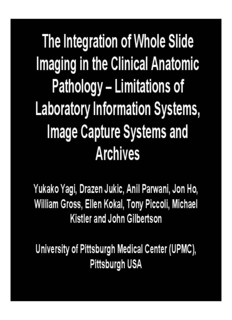
The Integration of Whole Slide Imaging in the Clinical Anatomic Pathology PDF
Preview The Integration of Whole Slide Imaging in the Clinical Anatomic Pathology
The Integration of Whole Slide Imaging in the Clinical Anatomic Pathology – Limitations of Laboratory Information Systems, Image Capture Systems and Archives Yukako Yagi, Drazen Jukic, Anil Parwani, Jon Ho, William Gross, Ellen Kokal, Tony Piccoli, Michael Kistler and John Gilbertson University of Pittsburgh Medical Center (UPMC), Pittsburgh USA Disclosure Page This work was partially supported by funding from the U.S. Air Force administered by the U.S. Army Medical Research Acquisition Activity (USAMRAA), 820 Chandler Street, Fort Detrick MD 21702- 5014, Contract No. DAMD17-03-2-0017. The content of the information does not necessarily reflect the position or policy of the U.S. Government and no official endorsement should be inferred. I (Yukako Yagi) have been Scientific Advisor for Trestle, DMetrix and Aperio. Background The past five years has seen the emergence of whole slide imaging robots – devices that can automatically image entire microscope slides at high speed and high resolution. A typical device can capture a slide in 5 minutes at tissue sampling rates of 0.3-0.5 microns/pixel, resulting in an uncompressed image file of 5 to 10 GB, and a typical pathology case contains ten slides. Though these “high resolution whole slide images” provide diagnostic information similar to that obtained by direct examination of tissue under the microscope and are proving useful in a variety of clinical activities; their novelty and sheer volume has resulted in a number of image and data management challenges. One of these challenges is that Laboratory Information Systems, which drive workflow and data management in pathology departments, are not well equipped to manage image level information. What is a whole slide image? Microscope Imaging If we try to send all information on a glass slide, It is more than 2.7GB/slide. Histology slides For Static Image Telepathology, a referring pathologist has to be able to select appropriate diagnostic fields. To select suitable fields for consultation requires experience Needed virtual slide A Digital Slide • A classical whole slide image is formed by imaging a entire physical (glass) slide, field by field, and then ‘knitting” these fields together to form a seamless montage • With some display software, one can pan and zoom around the image set Pyramid File Structure Low-magnification Mid-level magnification High-magnification Whole Slide Imaging • A Digital Slide is a massive data set File Size 6.6 um • Consider a WSI system: CCD • 0.6 NA, 20x Primary Magnification • 8.8 x 6.6 mm CCD • 6.6 um pixels • 0.33 um/pixel • 900 million pixels / square cm of tissue 20x Section • 3 bytes / pixel (24 bit color) • 2.7 GB / square centimeter of tissue per focal plane for the base image 0.33 um
Description: